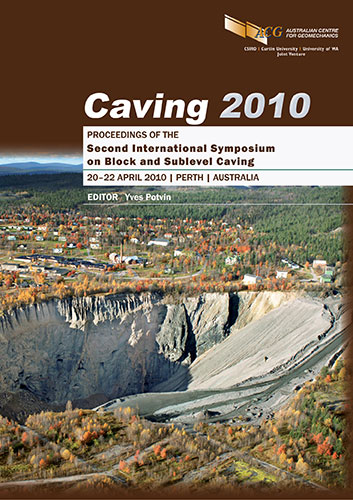Microseismic monitoring of hydraulic fractures in block cave mines

|
Authors: Joubert, PJ Paper is not available for download Contact Us |
DOI https://doi.org/10.36487/ACG_rep/1002_48_Joubert
Cite As:
Joubert, PJ 2010, 'Microseismic monitoring of hydraulic fractures in block cave mines', in Y Potvin (ed.), Caving 2010: Proceedings of the Second International Symposium on Block and Sublevel Caving, Australian Centre for Geomechanics, Perth, pp. 685-690, https://doi.org/10.36487/ACG_rep/1002_48_Joubert
Abstract:
Hydraulic fracturing can be used for preconditioning in block cave mining. Microseismic monitoring is one of the techniques used to determine the orientation, extent and time evolution of the hydraulically-generated fractures. Data is recorded continuously at significantly higher frequencies than currently used in routine seismic monitoring in mining environments, and the data analysis is accordingly more complicated. Microseismic monitoring was performed as part of the hydraulic fracturing program at Ridgeway Deeps Block Cave. The seismic data that is recorded during a typical fracture session has been described in detail. Frequency filtering and time domain methods are used to isolate the individual seismic events. A straight-ray method is used to estimate source location. A group of seismic events is then relocated with a double-difference method and the locations are used to describe the hydraulic fractures. Several hundred events from several different fracture sessions were located using this technique. For many fracture sessions, the locations are clearly planar, and estimates of strike and dip could be obtained. Fracture planes from consecutive fracture sessions were compared. The time evolution of individual fracture sessions was analysed and used to provide estimates of propagation rates. Criteria have been discussed for applying the technique to other hydraulic fracturing programmes.
References:
Paige, C.C. and Saunders, M.A. (1982) LSQR: An algorithm for sparse linear equations and sparse least squares, ACM Transactions on Mathematical Software 8(1), pp. 43–71.
Waldhauser, F. and Ellsworth, W.L. (2000) A double-difference earthquake location algorithm; method and application to the northern Hayward Fault, California, Bulletin of the Seismological Society of America 90(6),
pp. 1353–1368.
Zhang, H. and Thurber, C.H. (2003) Double-difference tomography: Method and its application to the Hayward Fault, California, Bulletin of the Seismological Society of America 93(5), pp. 1875–1889.
© Copyright 2025, Australian Centre for Geomechanics (ACG), The University of Western Australia. All rights reserved.
View copyright/legal information
Please direct any queries or error reports to repository-acg@uwa.edu.au
View copyright/legal information
Please direct any queries or error reports to repository-acg@uwa.edu.au